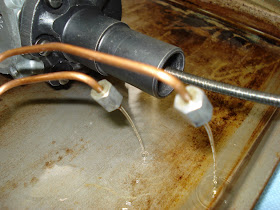After weeks of frustration we finally got our 1963 327 fuel injected engine to run on its own. We are extremely excited and we love the way it sounds. It's awesome!
ORIGINAL FOOTAGE OF THE FIRST SUCCESSFUL START
ADDITIONAL FOOTAGE
Note: I wasn't able to download the audio file mentioned in the second video. This blog does not accept that audio file type.
MYSTERY SOLVED - IT WAS THE HIGH PRESSURE FUEL PUMP
I spoke with Gary Hodges yesterday. Gary is one of just a few people that really know how these mechanical fuel injection units work. Gary has been dealing with these units for the last 40 years. Gary sells FI parts and his web page is http://www.garyhodgesramjet.com/2001.html
I discussed the high pressure fuel pump with Gary and he recommended that I scribe all three main housing pieces before I take the pump apart. Ty is scribing the fuel pump in this photo.
Double click on this picture to see the scribe lines. It's important.
Now, take note of the tiny hole on the end cap near the center of the pump.
This tiny hole is located on the high pressure side of the pump and it shouldn't be there. When the pump is running the fuel escapes through this hole and goes back into the fuel bowl, not to the injectors. The end cap had been installed 180 degrees out of position.
This is the correct orientation. The vent hole is now on the atmosphere side of the pump. We verified this by examining a picture of an original fuel pump found on Jerry Bramlett's web page. Check it out here http://www.jerrybramlett.net/museum.html
Note the missing scribe line on the cap.
It's on the opposite side now. The pump is now assembled properly.
Time to reassemble.
Everything lined up perfectly.
We hooked up the spider and gave the pump a test. OMG! We could have drowned in all that fuel!
We were running the drill motor on the lowest speed possible. Fuel was gushing out like never seen before. Whoo hoo!
So, what happened next? Why we grabbed our spouses and celebrated with a little bubbly of course! Check it out:
Thanks for watching.























































